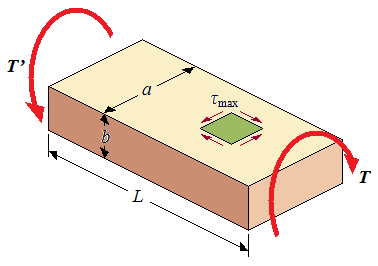Denoting by L the length of the bar, by a and b, respectively, the wider and narrower side of its cross section, and by T the magnitude of the torques applied to the bar as in Fig1, it is found that the maximum shearing stress occurs along the center line of the wider face of the bar and is equal to:
The angle of twist, on the other hand, may be expressed as:
The coefficients c1 and c2 depend only upon the ratio a/b and are given in Table I for a number of values of that ratio. Note that Eq1 and Eq2 are valid only within the elastic range.
Note that from Table I that for a/b ≥ 5, the coefficients c1 and c2 are equal. It may be shown that for such values of a/b:
The above is valid for a/b ≥ 5 only.
| 
Fig1
| a/b | c1 | c2
| | 1.0 | 0.208 | 0.1406
| | 1.2 | 0.219 | 0.1661
| | 1.5 | 0.231 | 0.1958
| | 2.0 | 0.246 | 0.229
| | 2.5 | 0.258 | 0.249
| | 3.0 | 0.267 | 0.263
| | 4.0 | 0.282 | 0.281
| | 5.0 | 0.291 | 0.291
| | 10.0 | 0.312 | 0.312
| | ∞ | 0.333 | 0.333
|
Table I.
|
